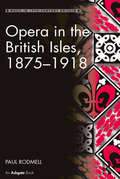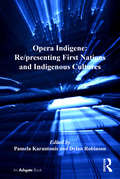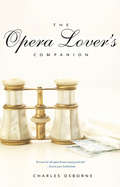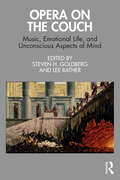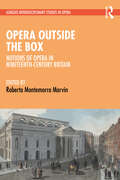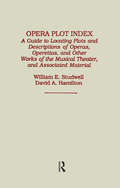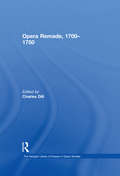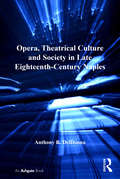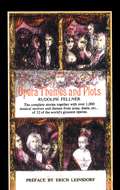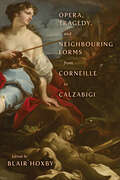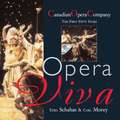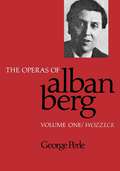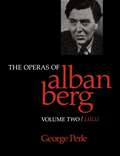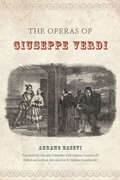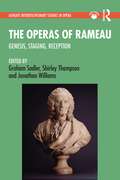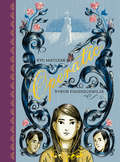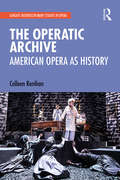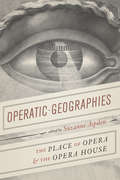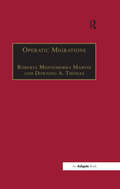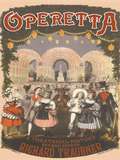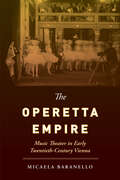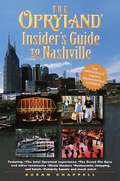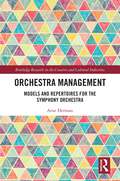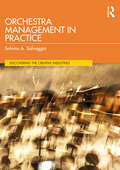- Table View
- List View
Opera in the Age of Rousseau
by David CharltonHistorians of French politics, art, philosophy and literature have long known the tensions and fascinations of Louis XV's reign, the 1750s in particular. David Charlton's study comprehensively re-examines this period, from Rameau to Gluck and elucidates the long-term issues surrounding opera. Taking Rousseau's Le Devin du Village as one narrative centrepiece, Charlton investigates this opera's origins and influences in the 1740s and goes on to use past and present research to create a new structural model that explains the elements of reform in Gluck's tragédies for Paris. Charlton's book opens many new perspectives on the musical practices and politics of the period, including the Querelle des Bouffons. It gives the first detailed account of intermezzi and opere buffe performed by Eustachio Bambini's troupe at the Paris Opéra from August 1752 to February 1754 and discusses Rameau's comedies Platée and Les Paladins and their origins.
Opera in the British Isles, 1875-1918 (Music in Nineteenth-Century Britain)
by Paul RodmellWhile the musical culture of the British Isles in the 'long nineteenth century' has been reclaimed from obscurity by musicologists in the last thirty years, appraisal of operatic culture in the latter part of this period has remained largely elusive. Paul Rodmell argues that there were far more opportunities for composers, performers and audiences than one might expect, an assertion demonstrated by the fact that over one hundred serious operas by British composers were premiered between 1875 and 1918. Rodmell examines the nature of operatic culture in the British Isles during this period, looking at the way in which opera was produced and 'consumed' by companies and audiences, the repertory performed, social attitudes to opera, the dominance of London's West End and the activities of touring companies in the provinces, and the position of British composers within this realm of activity. In doing so, he uncovers the undoubted challenges faced by opera in Britain in this period, and delves further into why it was especially difficult to make a breakthrough in this particular genre when other fields of compositional endeavour were enjoying a period of sustained growth. Whilst contemporaneous composers and commentators and later advocates of British music may have felt that the country's operatic life did not measure up to their aspirations or ambitions, there was still a great deal of activity and, even if this was not necessarily that which was always desired, it had a significant and lasting impact on musical culture in Britain.
Opera Indigene: Re/presenting First Nations And Indigenous Cultures (Ashgate Interdisciplinary Studies in Opera)
by Pamela Karantonis Dylan RobinsonThe representation of non-Western cultures in opera has long been a focus of critical inquiry. Within this field, the diverse relationships between opera and First Nations and Indigenous cultures, however, have received far less attention. Opera Indigene takes this subject as its focus, addressing the changing historical depictions of Indigenous cultures in opera and the more contemporary practices of Indigenous and First Nations artists. The use of 're/presenting' in the title signals an important distinction between how representations of Indigenous identity have been constructed in operatic history and how Indigenous artists have more recently utilized opera as an interface to present and develop their cultural practices. This volume explores how operas on Indigenous subjects reflect the evolving relationships between Indigenous peoples, the colonizing forces of imperial power, and forms of internal colonization in developing nation-states. Drawing upon postcolonial theory, ethnomusicology, cultural geography and critical discourses on nationalism and multiculturalism, the collection brings together experts on opera and music in Canada, the Americas and Australia in a stimulating comparative study of operatic re/presentation.
The Opera Lover's Companion
by Charles OsborneThis engaging guide to the 175 most popular operas will enhance the experience of every opera lover. Written by a well-known authority, the book consists of entries that set each opera within the context of its composer's career, outline the plot, discuss the music, and give relevant background information on the libretto, the staging, and the most famous and influential interpreters of the principal roles. In addition, the entries recount details of the first performance and subsequent performance history and provide guidance on the relative quality of available recordings. Aimed at opera lovers and committed newcomers rather than specialists, The Opera-Lover's Companion does not set out to cover every opera but only those most frequently encountered in opera houses or on recordings. Although the book is dominated by the five great opera composers-Mozart, Verdi, Wagner, Puccini, and Strauss-fifty-eight other composers are also represented. It is always more pleasurable to go to the opera with a knowledgeable and experienced companion. If you can't, you'll want to take this book.
Opera on the Couch: Music, Emotional Life, and Unconscious Aspects of Mind
by Steven H. Goldberg Lee RatherIn this widely ranging collection of essays, a group of contemporary psychoanalyst/authors turn their finely-honed listening skills and clinical experience to plumb the depths and illuminate themes of character, drama, myth, culture, and psychobiography in some of the world’s most beloved operas. The richly diverse chapters are unified by a psychoanalytic approach to the nuances of unconscious mental life and emotional experience as they unfold synergistically in opera’s music, words, and drama. Opera creates a unique bridge between thought and feeling, mind and body, and conscious and unconscious that offers fertile ground for psychological exploration of profound human truths. Each piece is written in a colorful and non-technical manner that will appeal to mental health professionals, musicians, academics, and general readers wishing to better understand and appreciate opera as an art form.
Opera Outside the Box: Notions of Opera in Nineteenth-Century Britain (Ashgate Interdisciplinary Studies in Opera)
by Roberta Montemorra MarvinOpera Outside the Box: Notions of Opera in Nineteenth-Century Britain addresses operatic “experiences” outside the opera houses of Britain during the nineteenth century. The essays adopt a variety of perspectives exploring the processes through which opera and ideas about opera were cultivated and disseminated, by examining opera-related matters in publication and performance, in both musical and non-musical genres, outside the traditional approaches to transmission of operatic works and associated concepts. As a group, they exemplify the broad array of questions to be grappled with in seeking to identify commonalities that might shed light in new and imaginative ways on the experiences and manifestations of opera and notions of opera in Victorian Britain. In unpacking the significance, relevance, uses, and impacts of opera within British society, the collection seeks to enhance understanding of a few of the manifold ways in which the population learned about and experienced opera, how audiences and the broader public understood the genre and the aesthetics surrounding it, how familiarity with opera played out in British culture, and how British customs, values, and principles affected the genre of opera and perceptions of it.
Opera Plot Index
by David Hamilton William E. StudwellFirst Published in 1990. Information about individual operas and other types of musical theater is scattered throughout the enormous literature of music. This book is an effort to bring that data together by comprehensively indexing plots and descriptions of individual operatic background, criticism and analysis, musical themes and bibliographical references. The principal audience for this general reference guide will be for the non-specialist, but its hoped that persons specialising in opera would also find it useful.
Opera Remade, 1700-1750
by Charles DillOpera in the first half of the eighteenth century saw the rise of the memorable composer and the memorable work. Recent research on this period has been especially fruitful, showing renewed interest in how opera operated within its local cultures, what audience members felt was at stake in opera performances, who the people-composers and performers-were who made opera possible. The essays for this volume capture the principal themes of current research: the "idea" of opera, opera criticism, the people of opera, and the emerging technologies of opera.
Opera, Theatrical Culture and Society in Late Eighteenth-Century Naples (Ashgate Interdisciplinary Studies in Opera)
by Anthony R. DelDonnaThe operatic culture of late eighteenth-century Naples represents the fullest expression of a matrix of creators, practitioners, theorists, patrons, and entrepreneurs linking aristocratic, public and religious spheres of contemporary society. The considerable resonance of 'Neapolitan' opera in Europe was verified early in the eighteenth century not only through voluminous reports offered by locals and visitors in gazettes, newspapers, correspondence or diaries, but also, and more importantly, through the rich and tangible artistic patrimony produced for local audiences and then exported to the Italian peninsula and abroad. Naples was not simply a city of entertainment, but rather a cultural epicenter and paradigm producing highly innovative and successful genres of stage drama reflecting every facet of contemporary society. Anthony R. DelDonna provides a rich study of operatic culture from 1775-1800. The book demonstrates how contemporary stage traditions, stimulated by the Enlightenment, engaged with and responded to the changing social, political, and artistic contexts of the late eighteenth century in Naples. It focuses on select yet representative compositions from different genres of opera that illuminate the diverse contemporary cultural forces shaping these works and underlining the continued innovation and European recognition of operatic culture in Naples. It also defines how the cultural milieu of Naples - aristocratic and sacred, private and public - exercises a profound yet idiosyncratic influence on the repertory studied, the creation of which could not have occurred elsewhere on the Continent.
Opera, Tragedy, and Neighbouring Forms from Corneille to Calzabigi
by Blair HoxbySince the nineteenth century, some of the most influential historians have portrayed opera and tragedy as wholly distinct cultural phenomena. These historians have denied a meaningful connection between the tragedy of the ancients and the efforts of early modern composers to arrive at styles that were intensely dramatic. Drawing on a series of case studies, Opera, Tragedy, and Neighbouring Forms from Corneille to Calzabigi traces the productive, if at times rivalrous, relationship between opera and tragedy from the institution of French regular tragedy under Richelieu in the 1630s to the reform of opera championed by Calzabigi and Gluck in the late eighteenth century. Blair Hoxby and his fellow contributors shed light on “neighbouring forms” of theatre, including pastoral drama, tragédie en machines, tragédie en musique, and Goldoni’s dramma giocoso. Their analysis includes famous masterpieces by Corneille, Voltaire, Metastasio, Goldoni, Calzabigi, Handel, and Gluck, as well as lesser-known artists such as Luisa Bergalli, the first female librettist to write for the public theatre in Italy. Opera, Tragedy, and Neighbouring Forms from Corneille to Calzabigi delves into a series of quarrels and debates in order to illuminate the history of seventeenth- and eighteenth-century theatre.
Opera Viva: The Canadian Opera Company The First Fifty Years
by Ezra Schabas Carl MoreyIt started with a festival - three classic operas performed in a theatre in Toronto. But when it became apparent that there was a need for a national opera company, an organization was founded that would go on to become one of the largest performing arts organizations in the country. The Canadian Opera Company was born in 1950, and is now one of the major opera companies in North America. The Company has toured extensively throughout Canada and the United States, and has delighted audiences as far away as Australia and Hong Kong, all the while finding the time to record frequently and develop special operatic presentations for children. More than just a group of performers, the COC also provides a training program for young professional singers, and a series of commissions of new works from both up-and-coming and established composers. Opera Viva is a history of the Company, but it is more than that: it is also a history of Canada’s cultural growth in the second half of the twentieth century, a time when the Canadian Opera Company became central to Canada’s musical life. As the story of the Company unfolds, the figures and personalities that were integral to the building of this landmark of Canadian culture are brought to life.
The Operas of Alban Berg, Volume I: Wozzeck
by George Perle"Of the greatest significance . . . . The first volume of George Perle's two volume study on the two operas of Alban Berg ... is one of those few works of scholarship and analysis you can label 'definitive'; it may in time be supplemented, but not superseded."--Richard Dyer, Boston Sunday Globe "It is difficult to see how Professor Perle's exhaustive study can ever be superseded. . . or how such future work as may appear can do anything but add new details to his exposition of the basic clements of the work's musical language. . . . After twenty years' work on the composer he brings to this study of Wozzeck not only a penetrating analytical mind, great scholarship and a comprehensive knowledge of the music but an almost uncanny insight into what seem to be the inner workings of Berg's mind."--Douglas Jarman, Music and Letters "If you have ever had any questions about Berg's opera Wozzeck, Mr. Perle probably answers them for you in The Operas of Alban Berg: Volume One/Wozzeck. . . An indispensable work on Berg's life as reflected in his work."--Donal Hcnahan, The New York Times "As with Perle's previous books, one notes with pleasure how well written is this one, how simultaneously economical and comfortable the prose, even when the subject is as complex and manifold as Wozzeck."--Mark DeVoto, Music Library Association Notes "A great and unique contribution .... [Perle] is a leading authority on Berg, and his analysis of Berg's compositional methods in the two operas is likely to be definitive."--George Martin, The Opera Quarterly "George Perle has contributed more than anyone of any nationality to a true understanding of Berg's music."--Douglass Green, Journal of Music Theory "George Perle ... possesses the kind of complete credential required for this study. [Volume I: Wozzeck] is a model of scholarly writing. Every paragraph, each quoted music example, each analysis moves the argument forward in a clear incisive manner .... Essential reading for the serious student of the music of Alban Berg."--Choice
The Operas of Alban Berg, Volume II: Lulu
by George Perle"The first volume of Perle's magnificent study focused on Wozuck ... .Its successor, equally painstaking and perceptive, is if anything more invaluable, for the clouds of mystery around Berg's second opera are only now beginning to disperse, and the work is coming to be regarded properly as the climax of the composer's achievement."--Andrew Clements, Opera "Perle's books have laid the groundwork for a thorough exploration of the remarkably successful ways in which Berg was able to marry a powerful intellectual grasp of a richly developing language to an instinctive feel for dramatic shape, a process that marks him out as one of the few genuine opera composers this century."--Michael Taylor, Music and Letters "The first volume, Wozzeck .... was universally recognized as being a work of outstanding scholarship. The Lulu volume is an even more impressive achievement. In its analytical sophistication, its critical insights and in the implications which it has for our understanding not only of Berg but of a whole body of post-diatonic music, Perle's Lulu is one of the most exciting and important books on music to appear for many years."--Douglas Jarman, Times Literary Supplement "With the second of his books on The Operas of Alban Berg, this American musicologist and composer has now taken advantage of all this new material to consolidate his own research and present us with the most sophisticated musical analysis yet made of the composer .... As Perle shows, Lulu represents the highest point of development in Berg's music from the point of view of ambiguity of fabrication."--Stephen Reeve, Classical Music "Nothing I've read in the past year makes as important a contribution to this literature as The Operas of Alban Berg: Volume Two: Lulu ..... Per!e's saga of the opera's release from partial captivity reads like one of the great intellectual detective stories of our era .... What emerges most flavorfully is Perle's portrait of a haunted artist who imbued his later works with concealed autobiographical gestures, including his longtime love affair with a Prague matron."--Ailan Ulrich, San Francisco Focus "The goal of the two-volume work is not merely to dwell in detail on the operas themselves, but to give some account of Berg's other music, in order to set the operas in the context of his complete output. With a composer like Berg, whose music is intimately bound up with his own personal life, such an approach is particularly appropriate .... George Perle has given the world two volumes which will remain at the top of their field for many years to come."--Douglass M. Green, Journal of the American Musicological Society
The Operas of Giuseppe Verdi
by Stefano Castelvecchi Abramo Basevi translated by Edward Schneider edited by Stefano CastelvecchiAbramo Basevi published his study of VerdiOCOs operas in Florence in 1859, in the middle of the composerOCOs career. The first thorough, systematic examination of VerdiOCOs operas, it covered the twenty works produced between 1842 and 1857OCofrom "Nabucco" and "Macbeth" to "Il trovatore," "La traviata," and "Aroldo. " But while BaseviOCOs work is still widely cited and discussedOCoand nowhere more so than in the English-speaking worldOCono translation of the entire volume has previously been available. "The Operas of Giuseppe Verdi "fills this gap, at the same time providing an invaluable critical apparatus and commentary on BaseviOCOs work. aAs a contemporary of Verdi and a trained musician, erudite scholar, and critic conversant with current and past operatic repertories, Basevi presented pointed discussion of the operas and their historical context, offering todayOCOs readers a unique window into many aspects of operatic culture, and culture in general, in VerdiOCOs Italy. He wrote with precision on formal aspects, use of melody and orchestration, and other compositional features, which made his study an acknowledged model for the growing field of music criticism. Carefully annotated and with an engaging introduction and detailed glossary by editor Stefano Castelvecchi, this translation illuminates BaseviOCOs musical and historical references as well as aspects of his language that remain difficult to grasp even for Italian readers. aMaking BaseviOCOs important contribution to our understanding of Verdi and his operas available to a broad audience for the first time, " The Operas of Giuseppe Verdi" will delight scholars and opera enthusiasts alike. "
The Operas of Rameau: Genesis, Staging, Reception (Ashgate Interdisciplinary Studies in Opera)
by Jonathan Williams Graham Sadler Shirley ThompsonIn recent years, interest in Rameau’s operas has grown enormously. These works are no longer regarded as peripheral by performers and audiences but are increasingly staged in the world’s major opera houses and festivals, while the production of first-rate recordings on CD and DVD continues to flourish. Such welcome developments have gone hand in hand with an upsurge in research on Rameau and his period. The present volume, devoted solely to the composer’s operas, reflects this scholarly activity. It brings together a substantial group of essays by an international team of scholars on a wide range of aspects of Rameau’s operas. The individual essays are informed by a variety of disciplines or sub-disciplines including literature, archival studies, musical analysis, gender studies, ballet and choreography, dramaturgy and staging. The contents are addressed to a wide readership, including not only scholars but also practical musicians, stage directors, dancers and choreographers.
Operatic
by Kyo MaclearA story of friendship, first crushes, opera and the high drama of middle school told by award-winning Kyo Maclear in her debut graphic novel.Somewhere in the universe, there is the perfect tune for you.It’s almost the end of middle school, and Charlie has to find her perfect song for a music class assignment. But it’s hard for Charlie to concentrate when she can’t stop noticing her classmate Emile, or wondering about Luka, who hasn’t been to school in weeks. Then, the class learns about opera, and Charlie discovers the music of Maria Callas. The more she learns about Maria’s life, the more Charlie admires her passion for singing and her ability to express herself fully through her music. Can Charlie follow the example of the ultimate diva, Maria Callas, when it comes to her own life?Key Text Featuresspeech bubblescaptionsbibliographyCorrelates to the Common Core State Standards in English Language Arts:CCSS.ELA-LITERACY.RL.4.3Describe in depth a character, setting, or event in a story or drama, drawing on specific details in the text (e.g., a character's thoughts, words, or actions).CCSS.ELA-LITERACY.RL.6.3Describe how a particular story's or drama's plot unfolds in a series of episodes as well as how the characters respond or change as the plot moves toward a resolution.CCSS.ELA-LITERACY.RL.6.6Explain how an author develops the point of view of the narrator or speaker in a text.
The Operatic Archive: American Opera as History (Ashgate Interdisciplinary Studies in Opera)
by Colleen RenihanThe Operatic Archive: American Opera as History extends the growing interdisciplinary conversation in opera studies by drawing on new research in performance studies and the philosophy of history. Moving beyond traditional aesthetic conceptions of opera, this book argues for opera’s powerful potential for historical impact and engagement in late twentieth- and twenty-first-century works by American composers. Considering opera’s ability to serve as a vehicle for memory, historical experience, affect, presence, and the historical sublime, this volume demonstrates how opera’s ability to represent and evoke historical events and historical experience differs fundamentally from the representations and recreations of other modes (specifically, literary and dramatic representations). Building on the work of performance scholars such as Joseph Roach, Rebecca Schneider, and Diana Taylor, and in consultation with recent debates in the philosophy of history, the book will be of interest to a wide range of scholars and researchers, particularly those working in the areas of opera studies and performance studies.
Operatic Geographies: The Place of Opera and the Opera House
by Suzanne AspdenSince its origin, opera has been identified with the performance and negotiation of power. Once theaters specifically for opera were established, that connection was expressed in the design and situation of the buildings themselves, as much as through the content of operatic works. Yet the importance of the opera house’s physical situation, and the ways in which opera and the opera house have shaped each other, have seldom been treated as topics worthy of examination. Operatic Geographies invites us to reconsider the opera house’s spatial production. Looking at opera through the lens of cultural geography, this anthology rethinks the opera house’s landscape, not as a static backdrop, but as an expression of territoriality. The essays in this anthology consider moments across the history of the genre, and across a range of geographical contexts—from the urban to the suburban to the rural, and from the “Old” world to the “New.” One of the book’s most novel approaches is to consider interactions between opera and its environments—that is, both in the domain of the traditional opera house and in less visible, more peripheral spaces, from girls’ schools in late seventeenth-century England, to the temporary arrangements of touring operatic troupes in nineteenth-century Calcutta, to rural, open-air theaters in early twentieth-century France. The essays throughout Operatic Geographies powerfully illustrate how opera’s spatial production informs the historical development of its social, cultural, and political functions.
Operatic Migrations: Transforming Works and Crossing Boundaries
by Roberta Montemorra Marvin Downing A. ThomasThis volume takes an interdisciplinary approach to studying a wide range of subjects associated with the creation, performance and reception of 'opera' in varying social and historical contexts from the eighteenth to the twentieth centuries. Each essay addresses migrations between genres, cultures, literary and musical works, modes of expression, media of presentation and aesthetics. Although the directions the contributions take are diverse, they converge in significant ways, particularly with the rebuttal of the notion of the singular nature of the operatic work. The volume strongly asserts that works are meaningfully transformed by the manifold circumstances of their creation and reception, and that these circumstances have an impact on the life of those works in their many transformations and on a given audience's experience of them. Topics covered include transformations of literary sources and their migration into the operatic genre; works that move across geographical and social boundaries into different cultural contexts; movements between media and/or genre as well as alterations through interpretation and performance of the composer's creation; the translation of spoken theatre to lyric theatre; the theoretical issues contingent on the rendering of 'speech' into 'song'; and the transforming effects of aesthetic considerations as they bear on opera. Crossing over disciplinary boundaries between music, literary studies, history, cultural studies and art history, the volume enriches our knowledge and understanding of the operatic experience and the works. The book will therefore appeal to those working in the field of music, literary and cultural studies, and to those with a particular interest in opera and musical theatre.
Operetta: A Theatrical History
by Richard Traubner"Operetta: A Theatrical History" is considered the classic history of this important musical theater form. Traubner's book, first published in 1983, is still recognized as the key history of the people and productions that made operetta a worldwide phenomenon. Beginning in mid-19th century Europe, the book covers all of the key developments in the form, including the landmark works by Strauss and his followers, Gilbert & Sullivan, Franz Lehar, Rudolf Friml, Victor Herbert, and many more. The book perfectly captures the champagne-and-ballroom atmosphere of the greatest works in the genre. It will appeal to all fans of musical theatre history.
The Operetta Empire: Music Theater in Early Twentieth-Century Vienna
by Micaela Baranello"When the world comes to an end," Viennese writer Karl Kraus lamented in 1908, "all the big city orchestras will still be playing The Merry Widow." Viennese operettas like Franz Lehár's The Merry Widow were preeminent cultural texts during the Austro-Hungarian Empire's final years. Alternately hopeful and nihilistic, operetta staged contemporary debates about gender, nationality, and labor. The Operetta Empire delves into this vibrant theatrical culture, whose creators simultaneously sought the respectability of high art and the popularity of low entertainment. Case studies examine works by Lehár, Emmerich Kálmán, Oscar Straus, and Leo Fall in light of current musicological conversations about hybridity and middlebrow culture. Demonstrating a thorough mastery of the complex early twentieth-century Viennese cultural scene, and a sympathetic and redemptive critique of a neglected popular genre, Micaela Baranello establishes operetta as an important element of Viennese cultural life—one whose transgressions helped define the musical hierarchies of its day.
The Opryland Insider's Guide to Nashville
by Susan ChappellNashville is an attraction of the tourists. Susan Chappell, a top Nashville writer has information about this place- the best hotels, the music venues, theaters, a schedule of annual events, historic day trips, river cruises, and specialty shops.
Orchestra Management: Models and Repertoires for the Symphony Orchestra (Routledge Research in the Creative and Cultural Industries)
by Arne HermanEvery orchestra in the world oscillates between crisis and survival. This perpetual movement makes innovation, both in organizational form and in artistic product, vital to the sustainability of the symphony orchestra. Based on case study research in Flanders, Amsterdam and London, this book reflects on the sustainability crisis of the orchestra by framing it as a legitimacy crisis that affects both the orchestra’s artistic and organizational identity. The aim of this book is to explore the dynamics between various and often conflicting factors in the orchestra’s quest for survival, and to show how these organizational dynamics relate to the orchestra’s repertoire. By highlighting the importance of every organization’s specific environment to which it needs to adapt, this book illustrates that the orchestra field is not a field that relies on best practices. The book reflects on conventional as well as innovative orchestra models, making the comparative point of view relevant for academic or practice-based researchers, orchestra managers, policymakers and subsidizing bodies interested in sustainable and future-oriented orchestra management.
Orchestra Management in Practice (Discovering the Creative Industries)
by Salvino A. SalvaggioIntroducing the business models, organisational structures, and fundamentals of orchestras, this book takes readers on a journey through the evolution of orchestra management. The author explores the dynamics between artistic excellence and financial sustainability. Key aspects of orchestra management are examined in detail, including artistic programming, strategic planning, financial and compliance/legal matters, audience development, resilience and adaptability, governance and board relations, diversity and inclusion, partnerships, and the role of technology and innovation. With actionable resources, such as checklists, templates, and frameworks, for current and future orchestra leaders and managers, this comprehensive guide empowers readers in education and practice to navigate the complexities of orchestra management confidently and effectively.

